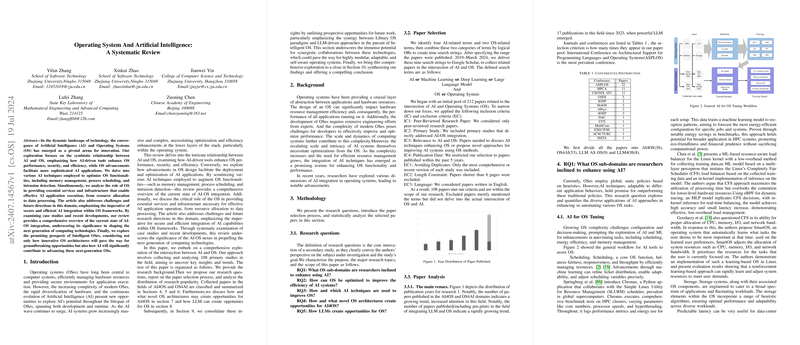Operating System And Artificial Intelligence: A Systematic Review
The intersection of AI and Operating Systems (OS) represents a dynamic convergence point poised to catalyze significant advancements in computing. The paper "Operating System And Artificial Intelligence: A Systematic Review" by Yifan Zhang et al., provides a comprehensive examination of the symbiotic relationship between AI and OS. This systematic review highlights the dual impact: AI-driven methodologies optimize OS functionalities, while developments in OS design refine and support AI applications. Both practical applications and theoretical implications are scrutinized, revealing rich opportunities and challenges in AI-OS integration.
Overview of the Study
The systematic review explores how AI enhances OS performance, security, and efficiency through various techniques. Furthermore, it explores how OS innovations support and optimize AI applications. The paper categorizes the surveyed studies into AI4OS, OS4AI, LLM AS OS, and LLM4OS. Through meticulous analysis, five key research questions (RQs) guide the exploration, each shedding light on different facets of the AI-OS nexus.
Key Findings
AI-Driven Enhancements for OS (AI4OS)
AI4OS highlights the integration of AI methodologies to refine OS functionalities. Specifically, it focuses on auto-tuning and security enhancements. Machine learning (ML) techniques such as Random Forest (RF), Recurrent Neural Networks (RNN), and Multi-Layer Perceptrons (MLP) are employed to optimize scheduling, energy efficiency, memory management, and intrusion detection. For instance, studies demonstrate using AI for load balancing in Linux kernels, memory address mapping for 3D-stacking memory, and intelligent malware detection. These approaches showcase AI's capabilities in dynamically adjusting OS parameters based on application behaviors, resulting in more efficient and secure operations.
OS Optimizations for AI (OS4AI)
OS4AI examines how OS modifications tailored for AI applications, particularly concerning AI accelerators, can significantly boost performance. Custom runtime systems and schedulers, high-speed I/O operations, and low-latency communication are critical areas where OS optimizations can drive AI efficiency. For example, NeuOS coordinates system- and application-level solutions for multi-DNN workloads, ensuring latency predictability and efficient energy use. Similarly, addressing the high I/O bandwidth demands of AI applications, solutions like hardware-based FPGA deployments have been proposed to reduce latency and variance in I/O communications.
Techniques for AI-OS Integration
The review identifies popular AI tools used in the enhancement of OS functionalities. RF and MLP models are particularly prevalent for their simplicity and effectiveness in tasks like load balancing and security enhancements. The diversity of AI methodologies, from ensemble learning to deep learning architectures, underscores the versatility required to address the multifaceted challenges in OS environments.
Novel OS Architectures
Emerging OS architectures such as LibOS and unikernels show promise in providing lightweight, modular alternatives to monolithic OS structures. These innovations are pivotal in scenarios requiring agility, security, and real-time processing. The Demikernel project exemplifies how a LibOS approach can enhance performance by bypassing traditional I/O paths, while unikernel-inspired improvements in Linux (UKL) illustrate significant latency reductions. Moreover, architectures like DBOS and LegoOS showcase decentralized management, aligning with the needs of contemporary AI-driven environments.
LLM Integration in OS
Integrating LLMs within OSes (LLM AS OS) and using LLMs to enhance OS functionalities (LLM4OS) mark a revolutionary shift in human-computer interaction. Projects like LLaMaS and AIOS-Agent ecosystems envision LLMs serving as OS modules, dynamically adapting to new hardware and optimizing system parameters through natural language processing. Moreover, advanced LLM-driven systems like MemGPT address the context window limitations of traditional models, enhancing their applicability across extensive tasks.
Implications and Future Directions
The research underscores the imperative of developing specialized, adaptive, and modular OS architectures that can seamlessly integrate AI capabilities. Future work is poised to explore:
- Resource-Constrained Environments: Developing efficient, lightweight OS solutions for IoT and edge devices is crucial.
- Granular Resource Management: Leveraging AI for dynamic and fine-tuned resource allocation will enhance efficiency and responsiveness.
- Security and Privacy: Ensuring robust, AI-infused security measures is paramount, particularly for sensitive applications.
- Intelligent Orchestration and Upgrades: Adopting principles from microservices to manage OS components can lead to more resilient and adaptable systems.
- LLM as OS Development: Exploring the full potential of integrating LLMs as core OS components to enhance user interaction, resource management, and security.
The intersection of AI and OS is rich with potential to redefine computing paradigms. By harnessing AI's adaptability and OS's foundational role, researchers and practitioners can drive forward innovations that support the next generation of intelligent systems. The comprehensive review presented by Zhang et al. provides both a solid foundation and a forward-looking perspective on this transformative domain.
